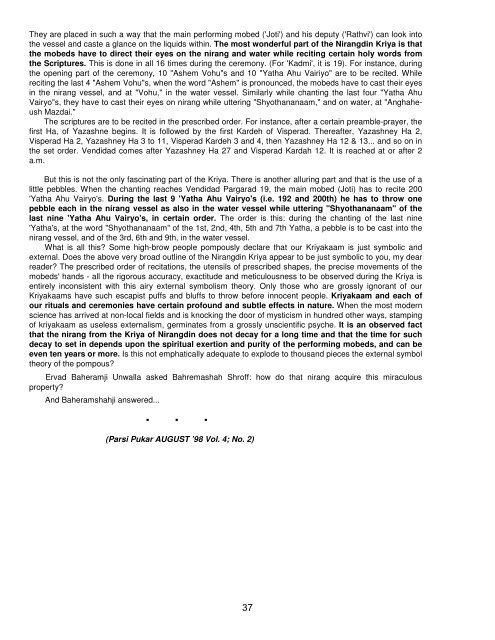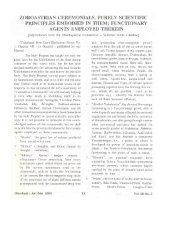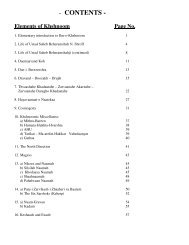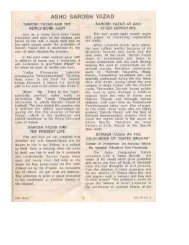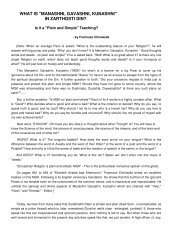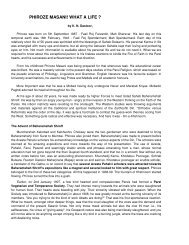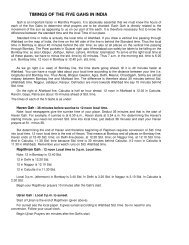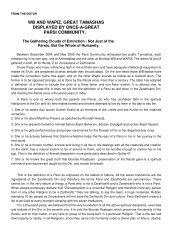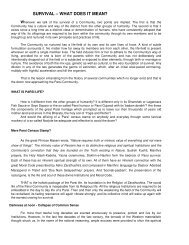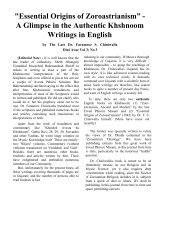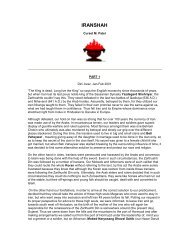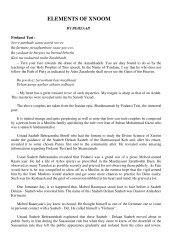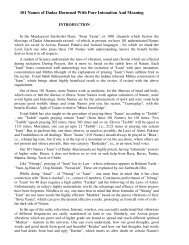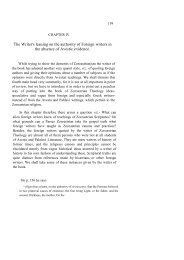Ilm-e-Khshnoom - Traditional Zoroastrianism: Tenets of the Religion
Ilm-e-Khshnoom - Traditional Zoroastrianism: Tenets of the Religion
Ilm-e-Khshnoom - Traditional Zoroastrianism: Tenets of the Religion
Create successful ePaper yourself
Turn your PDF publications into a flip-book with our unique Google optimized e-Paper software.
They are placed in such a way that <strong>the</strong> main performing mobed ('Joti') and his deputy ('Rathvi') can look into<br />
<strong>the</strong> vessel and caste a glance on <strong>the</strong> liquids within. The most wonderful part <strong>of</strong> <strong>the</strong> Nirangdin Kriya is that<br />
<strong>the</strong> mobeds have to direct <strong>the</strong>ir eyes on <strong>the</strong> nirang and water while reciting certain holy words from<br />
<strong>the</strong> Scriptures. This is done in all 16 times during <strong>the</strong> ceremony. (For 'Kadmi', it is 19). For instance, during<br />
<strong>the</strong> opening part <strong>of</strong> <strong>the</strong> ceremony, 10 "Ashem Vohu"s and 10 "Yatha Ahu Vairiyo" are to be recited. While<br />
reciting <strong>the</strong> last 4 "Ashem Vohu"s, when <strong>the</strong> word "Ashem" is pronounced, <strong>the</strong> mobeds have to cast <strong>the</strong>ir eyes<br />
in <strong>the</strong> nirang vessel, and at "Vohu," in <strong>the</strong> water vessel. Similarly while chanting <strong>the</strong> last four "Yatha Ahu<br />
Vairyo"s, <strong>the</strong>y have to cast <strong>the</strong>ir eyes on nirang while uttering "Shyothananaam," and on water, at "Anghaheush<br />
Mazdai."<br />
The scriptures are to be recited in <strong>the</strong> prescribed order. For instance, after a certain preamble-prayer, <strong>the</strong><br />
first Ha, <strong>of</strong> Yazashne begins. It is followed by <strong>the</strong> first Kardeh <strong>of</strong> Visperad. Thereafter, Yazashney Ha 2,<br />
Visperad Ha 2, Yazashney Ha 3 to 11, Visperad Kardeh 3 and 4, <strong>the</strong>n Yazashney Ha 12 & 13... and so on in<br />
<strong>the</strong> set order. Vendidad comes after Yazashney Ha 27 and Visperad Kardah 12. It is reached at or after 2<br />
a.m.<br />
But this is not <strong>the</strong> only fascinating part <strong>of</strong> <strong>the</strong> Kriya. There is ano<strong>the</strong>r alluring part and that is <strong>the</strong> use <strong>of</strong> a<br />
little pebbles. When <strong>the</strong> chanting reaches Vendidad Pargarad 19, <strong>the</strong> main mobed (Joti) has to recite 200<br />
'Yatha Ahu Vairyo's. During <strong>the</strong> last 9 'Yatha Ahu Vairyo's (i.e. 192 and 200th) he has to throw one<br />
pebble each in <strong>the</strong> nirang vessel as also in <strong>the</strong> water vessel while uttering "Shyothananaam" <strong>of</strong> <strong>the</strong><br />
last nine 'Yatha Ahu Vairyo's, in certain order. The order is this: during <strong>the</strong> chanting <strong>of</strong> <strong>the</strong> last nine<br />
'Yatha's, at <strong>the</strong> word "Shyothananaam" <strong>of</strong> <strong>the</strong> 1st, 2nd, 4th, 5th and 7th Yatha, a pebble is to be cast into <strong>the</strong><br />
nirang vessel, and <strong>of</strong> <strong>the</strong> 3rd, 6th and 9th, in <strong>the</strong> water vessel.<br />
What is all this? Some high-brow people pompously declare that our Kriyakaam is just symbolic and<br />
external. Does <strong>the</strong> above very broad outline <strong>of</strong> <strong>the</strong> Nirangdin Kriya appear to be just symbolic to you, my dear<br />
reader? The prescribed order <strong>of</strong> recitations, <strong>the</strong> utensils <strong>of</strong> prescribed shapes, <strong>the</strong> precise movements <strong>of</strong> <strong>the</strong><br />
mobeds' hands - all <strong>the</strong> rigorous accuracy, exactitude and meticulousness to be observed during <strong>the</strong> Kriya is<br />
entirely inconsistent with this airy external symbolism <strong>the</strong>ory. Only those who are grossly ignorant <strong>of</strong> our<br />
Kriyakaams have such escapist puffs and bluffs to throw before innocent people. Kriyakaam and each <strong>of</strong><br />
our rituals and ceremonies have certain pr<strong>of</strong>ound and subtle effects in nature. When <strong>the</strong> most modern<br />
science has arrived at non-local fields and is knocking <strong>the</strong> door <strong>of</strong> mysticism in hundred o<strong>the</strong>r ways, stamping<br />
<strong>of</strong> kriyakaam as useless externalism, germinates from a grossly unscientific psyche. It is an observed fact<br />
that <strong>the</strong> nirang from <strong>the</strong> Kriya <strong>of</strong> Nirangdin does not decay for a long time and that <strong>the</strong> time for such<br />
decay to set in depends upon <strong>the</strong> spiritual exertion and purity <strong>of</strong> <strong>the</strong> performing mobeds, and can be<br />
even ten years or more. Is this not emphatically adequate to explode to thousand pieces <strong>the</strong> external symbol<br />
<strong>the</strong>ory <strong>of</strong> <strong>the</strong> pompous?<br />
Ervad Baheramji Unwalla asked Bahremashah Shr<strong>of</strong>f: how do that nirang acquire this miraculous<br />
property?<br />
And Baheramshahji answered...<br />
. . .<br />
(Parsi Pukar AUGUST ’98 Vol. 4; No. 2)<br />
37


